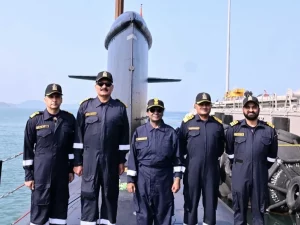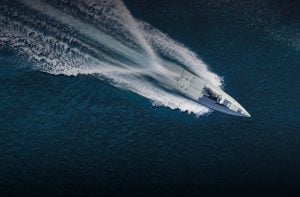“Dhruvastra” test-fired successfully
- Trials of India’s anti-tank guided missile ‘Dhruvastra’ has recently been successful at the Interim Test Range (ITR) in Odisha. The helicopter-launched Nag Missile (HELINA), which has now been named as ‘Dhruvastra’, is a third-generation fire and forget class anti-tank guided missile (ATGM) system mounted on the Advanced Light Helicopter (ALH).
- Last year, the Defence Research and Development Organisation (DRDO) carried out three successful test firings of the NAG missiles in the Pokhran firing ranges.
- According to DRDO website, “HELINA (Helicopter based NAG) is a third-generation fire and forget class anti-tank guided missile (ATGM) system mounted on the Advanced Light Helicopter (ALH). The system has all-weather day and night capability and can defeat battle tanks with conventional armour as well as explosive reactive armour.”
- “The HELINA missile can engage targets both in direct hit mode as well as top attack mode. HELINA Weapon Systems is being inducted into the Indian Army (IA). A variant of HELINA Weapon System called DHRUVASTRA is being inducted into the Indian Air Force (IAF),” it added.
- Earlier, the Defence Acquisition Council approved the procurement of the DRDO-designed and developed NAG Missile System (NAMIS) at the cost of Rs 524 crore. The induction of the NAG missile is expected to give a quantum boost to the Indian Army’s capability.
- According to Army technology website, key design and features of the NAG missile are:
- Nag is a third-generation, fire-and-forget, anti-tank guided missile to support both mechanised infantry and airborne forces of the Indian Army.
- The missile incorporates an advanced passive homing guidance system and possesses high single-shot kill probability. It is designed to destroy modern main battle tanks and other heavily armoured targets.
- Nag can be launched from land and air-based platforms. The land version is currently available for integration on the Nag missile carrier (NAMICA), which is derived from a BMP-2 tracked infantry combat vehicle.
- The helicopter-launched configuration, helicopter-launched NAG (HELINA), can be fired from Dhruv advanced light helicopter (ALH) and HAL Rudra (ALH WSI) attack helicopter.
- The Nag anti-armour guided weapon’s airframe is built with lightweight and high-strength composite materials. It features top-attack capability and has high immunity to countermeasures.
- The missile is equipped with four foldable wings and has a length of 1.85m, diameter of 0.20m, wingspan of 0.4m and weight of 43kg.
- A blunt nose cone houses the guidance system, while the middle portion accommodates a compact sensor package and the main charge of the warhead. A booster rocket motor is located towards the rear. Four tail fins are fitted at the rear to stabilise the missile while in flight.
- A real-time image processor with fast and efficient algorithms is installed next to the guidance section to provide automatic target detection and tracking capabilities. The digital autopilot offers guidance, stability, and control for the missile during the flight.
- Nag is also outfitted with an electric actuation system for flight control.
- Nag is fitted a with high-energy propulsion system consisting of booster and sustainer propellants. The sustainer propellant burns a nitramine smokeless extruded double base (EDB).
- It can fly at a speed of 230m/s and has the capability to engage both static and moving targets under all weather conditions during the day and at night. The range of the land version is 4km, while HELINA can reach up to 7km.
- Up to eight ready-to-fire missiles can be carried in two quadruple armoured box launchers mounted on the NAMICA anti-tank guided missile.
- Each launcher can fire four missiles in one minute. The NAMICA vehicle can be optionally equipped with an additional four missiles.
Indian Air Force Commanders’ Conference – July 2020
- The Air Force Commanders’ Conference (AFCC) was inaugurated by the Hon’ble Raksha Mantri Shri Rajnath Singh on 22 Jul 20 at Air Headquarters (Vayu Bhawan). Chief of the Air Staff, Air Chief Marshal RKS Bhadauria welcomed the Hon’ble Raksha Mantri and other senior officials from the MoD.
- In his address to the Air Force Commanders, Raksha Mantri appreciated the proactive response by the IAF in bolstering its operational capabilities over the past few months. He stated that the professional manner in which IAF conducted the air strikes in Balakot as well as rapid deployment of IAF assets at forward locations in response to the prevailing situation in Eastern Ladakh has sent a strong message to the adversaries. Raksha Mantri said that the nation’s resolve to defend its sovereignty stands firm on the faith its people have in the capability of its Armed Forces. He alluded to the ongoing efforts for de-escalation on LAC and urged the IAF to stand ready to handle any eventuality.
- He praised the stellar contribution by IAF in supporting the nation’s response to COVID-19 pandemic and the role played during several HADR missions. He highlighted the need to achieve self-reliance in defence production and noted that the theme chosen for this AFCC – ‘IAF in the Next Decade’ – was very apt for enhancing efforts towards indigenisation in the days to come. He lauded the progress made towards enhancing synergy and integration within the three services since the appointment of CDS and creation of DMA.
- The Raksha Mantri concluded by acknowledging IAF’s role in adapting to changes in technology and adopting emerging capabilities in Nano Technology, Artificial Intelligence, Cyber and Space domains. He assured the commanders that all requirements of the Armed Forces, whether financial or otherwise, would be fulfilled.
- The CAS in his address to the Commanders stated that the IAF was well prepared to counter short term as well as strategic threats and the units were evenly poised to counter any aggressive action by the adversary. He noted that the response by all Commands in ensuring deployment and readiness of forces was prompt and laudable. He emphasized on the need to focus on the ability to handle situations at a short notice for ensuring a robust response.
- During the three-day conference, commanders will review the current operational scenario and deployments before deliberating on building the IAF capabilities in the next decade to tackle all emerging threats.
China Fast-Tracks Key Defence Projects in Bangladesh
- For Chinese Ambassador in Bangladesh, Li Jiming, bringing Chinese companies to Dhaka is not the only priority. His ostensible goal seems to be expediting several key projects, including the ultra-modern submarine base project, BNS Sheikh Hasina, in Pekua, Cox’s Bazar.
- China has already delivered two submarines to Bangladesh Navy in its desperate bid to expand its footprints in the Indian sub-continent.
- Li Jiming (58), a career diplomat, has been instrumental in bringing Bangladesh Prime Minister Sheikh Hasina closer to Chinese President Xi-Jinping.
- In a joint statement of China and Bangladesh last year, Sheikh Hasina had not only backed Jinping’s Belt and Road Initiative (BRI), but she also agreed with China’s plans to bolster defence industry, including strengthening Bangladesh Navy and maritime management in Bay of Bengal.
- Though New Delhi enjoys cordial relations with the Sheikh Hasina government, Beijing eyes to increase its presence in the sub-continent through delivering subsidised infrastructure projects like ports, airports, or the ongoing submarine base in Cox’s Bazar.
- Top sources in Indian intelligence agencies revealed that Chinese state-owned company Poly Technologies Inc (PTI) has been assigned the submarine base project and a full-fledged construction, estimated to be worth 10,300 crore Bangladeshi taka, has begun at the site. The submarine base would have facilities like wharfs, barracks, ammunition depot and repairing dock.
- Sources in Indian agencies said that at the behest of Beijing, Chinese Ambassador Li Jiming has been tasked to expedite several core infrastructure projects in Bangladesh, including that of Cox’s Bazar.
- Li Jiming, who earlier had a stint with the government of Yunnan province, reportedly has a good rapport with top commanders of the People’s Liberation Army Navy (PLAN), currently overlooking the submarine project. Li Jiming also played a key role in the quick delivery of Chinese made Corvette to the Bangladesh Navy.
- Bangladesh had earlier received two submarines from China in 2016-17, which are operating from a makeshift base in Cox’s Bazar. After procuring these submarines, Dhaka had approached Beijing to lend its hand in building a modern submarine base for Bangladesh Navy.
- Dhaka is also founding a new naval base in Patkhauli that will have a submarine berthing and operation facilities to ensure the security of Payra seaport in southern Bangladesh.
- To strengthen its Naval forces, Prime Minister Hasina last month commissioned a Chinese Corvette named BNS Sangram. However, to balance the scale of relations with its neighbour, Hasina also praised India’s contribution in the liberation of Bangladesh. She reminded her countrymen how her father Sheikh Mujibur Rahman had started the newly independent country’s journey with extremely limited resources.
AIP Submarines Will Increase the Lethality of the Indian Navy
- Unlike its potential adversaries China and Pakistan, India has yet to adopt Air Independent Power (AIP) for its submarines. Also known as Air Independent Propulsion, this technology allows a non-nuclear submarine to operate for longer without having to surface. This makes it harder to detect and allows it to patrol in high-risk areas for longer.
- But AIP is coming to Indian submarines. The current Kalvari class boats are expected to receive an Indian-made system. This should greatly increase the potency of India’s non-nuclear submarines.
- Indian engineers have been working on an indigenous AIP system. Engineering firm Larsen & Toubro has built and tested a prototype system that fits inside the Kalvari’s hull. The company is also involved in India’s indigenous nuclear-powered submarine.
- According to people familiar with the situation, the plan is for each of the Kalvari class submarines to be retrofitted with the indigenous AIP. This should happen six to seven years after commissioning. It would be mounted in a hull extension that is inserted between the crew area and the engine space. The locally designed system is expected to extend the endurance of the submarines by two weeks.
- India will operate six of the Kalvari class, which are the newest non-nuclear submarines in the Indian fleet. They are a version of the French-designed Scorpène type submarines. In the French lineage these are a generation newer than the Agosta Class boats in service with neighbouring Pakistan.
- Some of Pakistan’s Agostas already have AIP, which for the moment may confer some advantages to them. Unlike the Indian subs, which will use fuel cells, the Pakistan Navy submarines use the MESMA (Module d’Energie Sous-Marine Autonome) system. This burns ethanol with stored oxygen to produce steam, which turns a turbine similar to a nuclear power plant.
- Pakistan is buying eight Type 093B submarines from China that will come with another type of AIP called a Stirling generator, which uses a closed-cycle diesel engine. These are essentially the same as China’s own AIP submarines, 17 of which are believed to be in service. The Stirling generator is famous because of the Swedish Navy’s use, and it is also the type used by Japan.
- Submarine warfare expert Aaron Amick, author of the Sub Brief podcast, believes that AIP will give the Indian Navy strategy advantages over the current non-nuclear submarines. He says that it will “force their closest rival, Pakistan, to be more vigilant over a wider area. Improving their Scorpene submarines with AIP will balance India with Pakistan’s new Type 093B Chinese subs that are due in 2023.”
- AIP is essential in the 21st century, open water battle space. Submarines only get one chance to attack from stealth and AIP gives them the best opportunity for success.
- The Indian project will take years to put in place. For some time Pakistan’s AIP submarines will continue to out-number India’s. But the indigenous fuel cell technology will allow India to increase the usefulness of their conventional submarines. Adding to this India’s nuclear-powered submarines and the Indian Navy should be able to retain a competitive edge. And India’s next generation Project-75I boats will get AIP from the get-go.
#KnowYourNavy – INAS 313
- INAS 313 is known as the ‘Sea Eagle’ Squadron of Indian Navy.
- It was commissioned on 22 July 2019.
- It operates the versatile Short-Range Maritime Reconnaissance Dornier aircraft capable of all-weather, day & night operations.
- INAS 313 undertakes maritime reconnaissance, coastal surveillance, fleet support missions, search & rescue, combat free fall and casualty evacuation.
- The motto of the Sea Eagle squadron is ‘Mighty Wings, Dauntless Spirit’.
REVIEW QUESTIONS
- Dhruvastra is a variant of which missile?
- Astra
- BrahMos
- Nag
- Trishul
ANSWER: C
- Who is the current Chinese Ambassador in Bangladesh interested in bringing Chinese companies to Dhaka and in expediting key defence projects between both the nations?
- Zhang Hanhui
- Li Jiming
- Sun Weidong
- Cui Tiankai
ANSWER: B
- To strengthen its Naval forces, Prime Minister of Bangladesh Sheikh Hasina, last month commissioned a Chinese Corvette named:
- BNS Ali Haider
- BNS Bangabandhu
- BNS Shadhinota
- BNS Sangram
ANSWER: D
- Which private engineering firm has built and tested a prototype AIP system that fits inside the Kalvari class submarine’s hull?
- Tata Defence Systems
- Larsen & Toubro
- Reliance Industries
- Mahindra Defence
ANSWER: B
- INAS 313 is known as what squadron of Indian Navy?
- The ‘Sea Eagles’ Squadron
- The ‘Black Panthers’ Squadron
- The ‘Winged Stallions’ Squadron
- The ‘Flying Sentinels’ Squadron
ANSWER: A
- The motto of the Sea Eagle squadron is:
- ‘Conquering Naval Air Spirit’
- ‘Higher, Intangible, Incredible’
- ‘Mighty Wings, Dauntless Spirit’
- ‘Flying Spirits of the Seas’
ANSWER: C



















